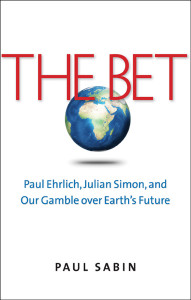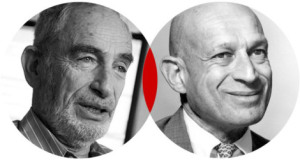In 1980, economist Julian Simon challenged well-known biologist and environmentalist Paul Ehrlich to a bet that, as author Paul Sabin writes “would leave their legacies forever intertwined.” Ehrlich bet Simon that metal prices would rise in the decade that followed, and that when they did it would prove that “population growth caused resource scarcity.”
Simon disagreed, and thought markets and new technologies “would drive prices down,” which would prove “that society did not face resource constraints and th at human welfare was on a path of steady improvement.”
at human welfare was on a path of steady improvement.”
The Bet is so much more than the bet and who ends up “winning” it. In this book, Sabin takes readers into how each of these men became influential in their own right as respected thinkers on population growth and the Earth’s resources, and why their theories were so utterly divergent.
We learn how the younger lives of both of these men influenced their thinking and passions in their professional lives as adults. Sabin describes Ehrlich as finding purpose “in fulfilling humanity’s moral obligation to preserve nature and restore balance between society and ecosystems.” In devising his theories, he “extrapolated from biological systems and nonhuman populations to the fate of human societies.”

Ehrlich and Simon
Simon, on the other hand, questioned the “distinctive importance of natural resources,” and emphasized human capital, technology and innovation.” He believed that “markets would successfully manage the depletion of resources by developing substitutes, moderating demand, and stimulating production.”
In Simon’s eyes, continued population growth is nothing but good – it should “thrill rather than frighten us.” Ehrlich could not disagree more. He believed “there are fundamental ecological limits that economics could not overcome, and that population growth would ultimately outstrip available resources.” While Ehrlich viewed “scarce resources as a fundamental constraint that either forced dramatic change or provoked crisis, economists like Simon saw scarcity and abundance as constantly shifting, dynamic variables,” and “new technologies are allowing us to use our old resources more efficiently that they actually create new resources.”
Sabin takes us through the influence both of these men had on scientific, academic and political spheres, and sheds valuable light onto who and what was truly “right” about what drove commodity prices over the course of the bet.
Readers learn the intricacies of how a biologist and an economist could see population growth and resource consumption so differently, and why each differed so greatly in how “they measured the state of the world.”
The core of the differences rests with different sets of values. Science historian Naomi Oreskes articulates it this way: “Many environmental claims are not so much about life’s quantities as its qualities. They are about equity and aesthetics. Humans might improve their material lives by despoiling the planet, but does that mean they should?”
Sabin helps us see what we can take from each of these men’s divergent positions to help “frame our thinking about the future.” The Bet is a well-written, engaging read for anyone interested in how we got to where we are today on population growth, overpopulation, the debate on climate change, and in answering the larger ethical question, “What kind of world do we desire?”

